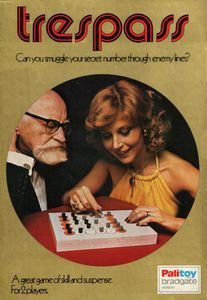Trespass
- Board's Eye View

- Aug 25, 2017
- 4 min read
Updated: Dec 3, 2019
The review here is one I wrote that was originally published in Games & Puzzles magazine.
*********************************************************************
Hoping to turn to advantage my years of legal training, I was delighted to find a game on the market entitled Trespass. Would the game deal with the wide legal definition of trespass as interference with person or property or would it restrict itself to what the layman usually regards as trespass and lawyers refer to as trespass quare clausum fregit, which is basically invasion of land? My imagination had got the better of me and I had already raced for my copy of Street on Torts when it occurred to me that publishers Palitoy might merely be using the name Trespass as a catchy title and that far from it being a game for lawyers it might be yet another of those abstract games where the only law involved is the law of probabilities and at which all those cursed mathematicians always excel.

Needless to say my latter supposition was at least partially correct - Trespass certainly is an abstract game, although happily and refreshingly it is one at which ordinary mortals can compete on surprisingly equal terms with all those computer scientists.
Played on a 5 x 6 grid, each of the two players has ten numbered pegs which are placed randomly in the player's back two rows. Each player secretly chooses one of the numbered pegs as his key peg and writes the number on a piece of paper. The object of the game is to manoeuvre one's chosen numbered peg into any empty space in one's opponent's back row, and this is achieved by moving any peg forward and/or sideways (changes in direction are allowed in any turn) any distance, provided a peg's path is not obstructed by other pegs. Players are allowed to jump over one or more pegs (of either colour) as in draughts, although pegs jumped remain on the board. Whilst a peg can in any turn move and then jump, it cannot move after it has jumped in any turn.
Where Trespass scores for originality is in its rule allowing a player in any turn to move either his own or his opponent's pieces. This is restricted only by a rule preventing a player from moving a peg that has been moved by his opponent in the previous turn, and adds considerably to what could otherwise be a ludicrously simple and fairly dull game. lt is so fundamental to the playability of the game that it soon becomes evident that the best strategy to pursue is to move only one's opponent's pegs until one is ready to move one's chosen numbered peg 'in for the kill'.
Typically, players will move the pegs from their opponent's back row creating spaces which will be immediately accessible to several of their pegs. At this point an opponent may attempt to play defensively by moving sideways a peg in his back row, but this will only delay the inevitable so that the best strategy is to immediately move one of one's opponent's pegs into the back row, gambling that the peg one moves is not the peg one's opponent has selected. The first time this is done in the course of the game, one is usually relying merely on chance but as the game progresses (if one doesn't suffer a sudden 'death') a player is increasingly able to detect from his opponent's moves which pegs are definitely not the chosen peg (unless one's opponent is attempting a bluff!) and therefore which to move into one's back row to fill up the spaces and prevent one's opponent's victory. As pegs cannot move backwards, once an opponent's peg is in one's back row it cannot be removed and so one's opponent's opportunities for victory are reduced.
lt is easy to dismiss Trespass as shallow on the strength (or weakness) of its opening strategy, as if one plays as suggested above and is unlucky in the gamble as to which of one's opponent's pegs to move home, a game can end in only three moves. However, Trespass is a game which should be played a fair number of times before being judged so that one has the opportunity to appreciate its finer points. The rules of Trespass are well written and clearly illustrated, although one member of the Games & Puzzles Testing Panel suggested that a very strict interpretation of the rules was possible, allowing only one change of direction in moving a peg. Apart from the rules, the playing equipment is economical but adequate, comprising two sets of numbered plastic pegs and the playing grid which is printed on card in the base of the box.
Most noticeably lacking is some form of number indicator which might have been incorporated into the design of the box/board and which would have been a useful refinement as it would have avoided the need to scrawl numbers on scraps of paper.
(Review by Selwyn Ward)




